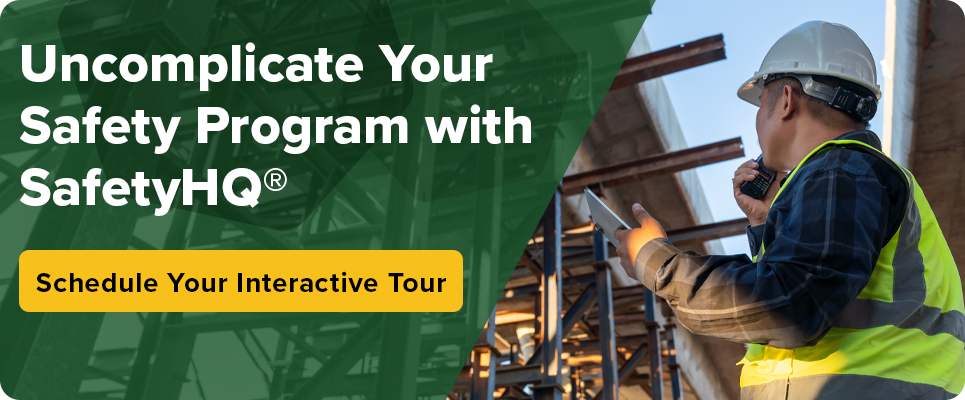
At some point during the bidding process on a large construction project, it is very likely you will be asked to submit a site-specific safety plan. Builders and general contractors want to confirm you will be operating a safe job site because they don’t want any accidents or construction injuries taking place where they may be held liable.
They likely don’t have the time or resources to oversee every single sub all the time. Requesting the site-specific plan is their way of confirming they can trust you to be safe.
You probably already have a written safety manual that covers all your general safety policies and procedures. This manual, although applicable on all your job sites, isn’t what they are looking for.
A site-specific safety plan takes your standard processes and modifies them for that job site specifically. It also includes additional hazards and control measures and specific emergency information.

What Should Go in a Site-Specific Safety Plan?
Even if a client or general contractor isn’t asking for one, you should create a site-specific safety plan for all major jobs that:
- your crews will be on for an extended period of time and/or
- pose unusual hazards your workers are not accustomed to controlling
Here is what should go in every plan:
1. Emergency Information
Emergencies can be very disorienting and confusing for those involved. In the event that one occurs, it’s best to have all the information your employees need readily available so nobody has to scramble.
Start by listing the emergency contacts, with their name, role, and phone number or email. This should include a safety director or upper management from both your company and for the client or general contractor.
Include the location of the nearest hospital and, optionally, the location of the nearest non-emergency medical clinic for injuries such as sprains or small cuts requiring a stitch. Some company health insurance policies stipulate preferred treatment providers. Check your policy to see which providers in your area are in network with your insurance.
OSHA mandates every employer provide reasonable access in terms of time and distance to medical facilities for their employees. If that is not possible, one option the standard provides is to have an employee trained in First Aid / CPR on site. In fact, they recommend this regardless of the location of the nearest hospital.
Since the term ‘reasonable’ is left open to interpretation by an inspector, we recommend having someone trained on site, ensuring full compliance with the regulation.
The name of that competent person responsible for leading the team through an emergency should be recorded on the safety plan.
Finally, you should make notes of the locations of all available first aid kits and equipment such as defibrillators.
2. Hazards
You likely have a list of common hazards faced by your crew in your safety manual, and it is completely acceptable to copy and paste them into your site-specific safety plan if they are applicable.
In addition to the standard hazards, you need to consider any others that are likely to present themselves. If there is a possibility of conducting a walk-through of the site, we encourage doing that. If there is nothing to see at the bid stage, try and get to the site a few weeks before your crews are scheduled to do the work and update the safety plan.
Hazards differ from trade to trade and even from jobsite to jobsite; however, some areas to consider (but not limited to) are:
- Any areas with the potential for a fall from over 6 feet
- Use of compressed air/gas
- Working in confined spaces
- Presence of electricity
- Proximity to or use of open flame
- Use of elevated work platforms
- Potential silica exposure
- Operation of heavy equipment
3. Controls
The National Institute for Occupational Safety and Health (NIOSH), outlines the most effective hazard controls down to the least effective in the figure below.
(image source: NIOSH)
For every hazard you list in your safety plan, you must include at least one control method your employees will use to protect themselves. The most effective control is ‘Elimination,’ which physically removes the exposure of the hazard. This is the level of control you should always aim for, but isn’t always possible.
The least effective control is ‘Personal Protective Equipment’ and is best used if paired with one other control method from the middle of the diagram below.
If you need help creating controls, check with your local trade association, as they often have this type of information available to their members.
This is the most important aspect of your site-specific safety plan, so the majority of your time and effort should go into this section.
4. Equipment
Once you have your list of controls outlined, you need to review them and generate a list of required safety equipment. This could include equipment that will be installed at the site, such as guard rails, or provided to your employees, like a hard hat.
The more specific and accurate you can be with this list, the better the pre-production team can prepare. Nobody wants to send a crew to a job site only to discover they can’t start because they are missing safety equipment.
5. Pictures
Including pictures in your site-specific safety plan makes the chances of successful transfer of information all the more likely. As we mentioned above, it is ideal to be able to conduct a site walkthrough and capture images of the actual hazards the crew will be faced with.
However, depending on the specs of the project, that may not be possible. Even so, there’s no reason why you can’t provide example photos of each hazard and each control.
For example, for floor openings, you could add a picture of a floor opening on a different project, as well as the proper setup of a guardrail system.
When utilized, images are a fantastic resource for the workers to prepare for what they are about to be faced with.
The Plan Is Useless Unless Implemented
Once your bid is accepted and in advance of the project starting, share the plan with the supervisors and key workers who will be on site. They should put some forethought into it and collect the equipment they will need from your list.
On the first day of the project, meet with all workers assigned to the job to review the plan and do a physical walkthrough of the site. Taking the time to complete these steps will significantly reduce the chance of an incident onsite.
How SafetyHQ Can Help
SafetyHQ is a safety management system that provides you with access to a digital ‘Site-Specific Safety Plan’ form. The form prompts you to enter the required information and outputs a PDF, which can be shared throughout the company or with clients.

The PDF also attaches to the Project file inside SafetyHQ and appears in the project summary. This ensures your employees have access to everything they need to know in order to be safe on the job site, right in the palm of their hands
To find out more about how SafetyHQ makes safety easy and convenient, click the button below to book a demo.
Share Article
Keep on current news in the construction industry. Subscribe to free eNews!



